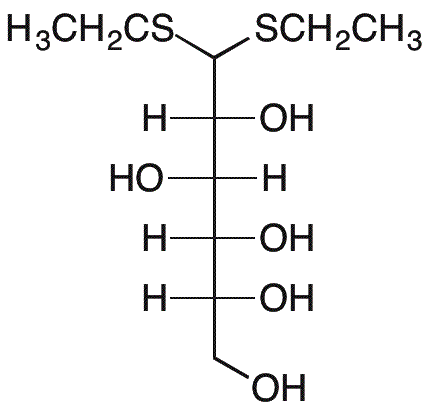D-Glucose diethylmercaptal is widely utilized in research focused on:
- Pharmaceutical Development: This compound serves as a building block in the synthesis of various pharmaceuticals, enhancing drug solubility and bioavailability.
- Food Industry: It is used as a flavoring agent or sweetener in food products, providing a natural alternative to synthetic sweeteners.
- Biochemical Research: Researchers employ it in studies related to carbohydrate metabolism and enzymatic reactions, aiding in the understanding of metabolic pathways.
- Cosmetics: The compound is incorporated into cosmetic formulations for its moisturizing properties, improving skin hydration and texture.
- Polymer Chemistry: It acts as a cross-linking agent in the production of biodegradable polymers, contributing to environmentally friendly materials.
General Information
Properties
Safety and Regulations
Applications
D-Glucose diethylmercaptal is widely utilized in research focused on:
- Pharmaceutical Development: This compound serves as a building block in the synthesis of various pharmaceuticals, enhancing drug solubility and bioavailability.
- Food Industry: It is used as a flavoring agent or sweetener in food products, providing a natural alternative to synthetic sweeteners.
- Biochemical Research: Researchers employ it in studies related to carbohydrate metabolism and enzymatic reactions, aiding in the understanding of metabolic pathways.
- Cosmetics: The compound is incorporated into cosmetic formulations for its moisturizing properties, improving skin hydration and texture.
- Polymer Chemistry: It acts as a cross-linking agent in the production of biodegradable polymers, contributing to environmentally friendly materials.
Documents
Safety Data Sheets (SDS)
The SDS provides comprehensive safety information on handling, storage, and disposal of the product.
Product Specification (PS)
The PS provides a comprehensive breakdown of the product’s properties, including chemical composition, physical state, purity, and storage requirements. It also details acceptable quality ranges and the product's intended applications.
Certificates of Analysis (COA)
Search for Certificates of Analysis (COA) by entering the products Lot Number. Lot and Batch Numbers can be found on a product’s label following the words ‘Lot’ or ‘Batch’.
Numéro de catalogue
Numéro de lot/série
Certificates Of Origin (COO)
This COO confirms the country where the product was manufactured, and also details the materials and components used in it and whether it is derived from natural, synthetic, or other specific sources. This certificate may be required for customs, trade, and regulatory compliance.
Numéro de catalogue
Numéro de lot/série
Safety Data Sheets (SDS)
The SDS provides comprehensive safety information on handling, storage, and disposal of the product.
DownloadProduct Specification (PS)
The PS provides a comprehensive breakdown of the product’s properties, including chemical composition, physical state, purity, and storage requirements. It also details acceptable quality ranges and the product's intended applications.
DownloadCertificates of Analysis (COA)
Search for Certificates of Analysis (COA) by entering the products Lot Number. Lot and Batch Numbers can be found on a product’s label following the words ‘Lot’ or ‘Batch’.
Numéro de catalogue
Numéro de lot/série
Certificates Of Origin (COO)
This COO confirms the country where the product was manufactured, and also details the materials and components used in it and whether it is derived from natural, synthetic, or other specific sources. This certificate may be required for customs, trade, and regulatory compliance.


